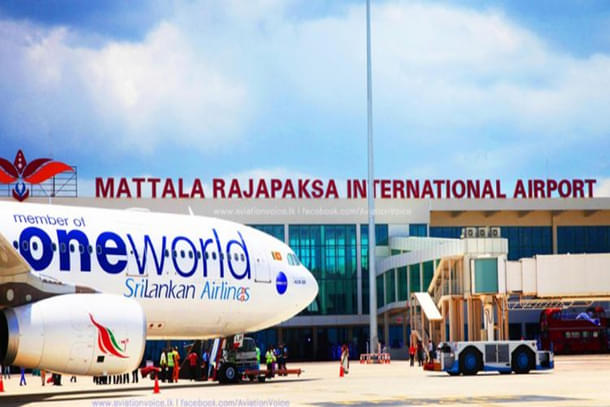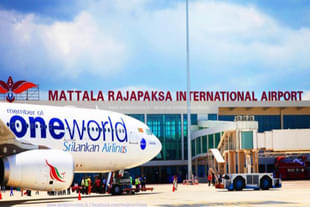World
India Expanding Footprint In Sri Lanka, But China Still In Control
Amit Mishra
May 15, 2024, 05:38 PM | Updated 05:38 PM IST
Save & read from anywhere!
Bookmark stories for easy access on any device or the Swarajya app.


New Delhi may finally be finding ways to gain ground in Colombo, a region with China's formidable presence, as President Ranil Wickremesinghe's administration is increasingly engaging Indian companies for vital projects.
On 13 May, the country’s cabinet cleared a proposal for a 20-year power purchase agreement with Adani Green Energy for the development of wind power stations to produce 484 MW of power.
The $442 million renewable energy project involves development of two wind power stations in Mannar and Pooneryn, in Sri Lanka’s Northern Province.
The announcement comes just weeks after the island nation's decision to entrust a Russia-India joint venture with the management of the financially struggling Mattala Rajapaksa International Airport.
Situated in Hambantota, 240 kilometres southeast of Colombo, this airport, named after former president Mahinda Rajapaksa, was financed by the Export-Import Bank of China at a cost of $209 million.
Yet, controversy envelops the project due to low flight traffic and persistent financial losses, leading to its infamous title as the "world’s emptiest airport".
A consortium of three parties led by Adani Ports is also developing the West Container Terminal (WCT), a deep-water container facility at the Port of Colombo that will strengthen Sri Lanka’s export capabilities in the Indo-Pacific.
The $700 million WCT project was offered as a “compromise” to India after Colombo “unilaterally” cancelled the 2019 East Container Terminal (ECT) agreement and is said to be the largest foreign investment in the island nation’s ports sector.
In November 2023, the US International Development Finance Corporation (DFC) announced a $553 million investment in the WCT project.
Together, these developments point to Indian government's systematic efforts to counter China's influence by leveraging its presence in important Sri Lankan infrastructure projects.
Two things, however, need to be kept in mind.
One, there are allegations of Indian government favouring some players over others in Sri Lanka, which is adding to the anti-India sentiment.
Two, the efforts of the Indian government are a beginning but Chinese influence in Sri Lanka is not going anywhere.
Favouritism?
Even though New Delhi encourages Indian companies to view Sri Lanka as a potential investment destination, it also faces accusations of interfering in the competitive process and prioritising some players over others.
For example, the Adani Group entered as a “nominee” of the government of India in both the wind energy as well port terminal project, and not through a competitive bid, raising questions about procedural fairness.
At a time when anti-Indian sentiments are on the rise, New Delhi would be wise to address any such allegations of preferential treatment. Selecting a global player like Adani through transparent procedures could foster considerable goodwill.
The Sri Lankan government's decision to entrust the management of the Mattala airport to the joint venture of India's Shaurya Aeronautics and Airports of Regions Management Company of Russia underscores the importance of due process. The joint venture was chosen following a call for expressions of interest issued by the Sri Lankan Cabinet in January of this year.
Continued Dominance Of China
The Mattala airport lies less than 30 kilometres from the Hambantota Port, which was also built with Chinese funds and is being managed by China since 2017.
New Delhi has been wary of China expanding its influence into the Indo-Pacific, with Sri Lanka as its base. The presence of Mattala airport could offer a degree of reassurance in this regard.
Having said so, the projects at present do not put India into the driving seat.
As a key transit hub with half of the world's container ships passing through its waters, the island nation of 22 million attracts attention from India, China, and other major players.
However, as Colombo grapples with restructuring its towering debt and recovering from its worst economic crisis as an independent nation, opportunities are being sensed by all, setting the stage for geopolitical manoeuvring.
While China has shown willingness to restructure Sri Lanka's $36.4 billion outstanding foreign loans, it is also increasing direct investments in the country.
For example, in November 2023, Sri Lanka approved a proposal from Chinese state-owned oil giant Sinopec to construct a $4.5 billion refinery in Hambantota Port, marking the largest investment in Sri Lanka since its economic crisis in 2022. This initiative, if successful, could mitigate Sri Lanka's fuel shortage issues.
In essence, the economic turmoil has presented Colombo with a delicate balancing act as it seeks other partners, notably India, to hedge the risk of Chinese dominance and preserve bargaining power with major stakeholders.
For New Delhi, while the recent developments are significant, they may not substantially alter the broader geopolitical dynamics of the region.





